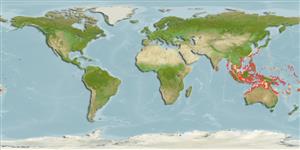Common names from other countries
Classification / Names / Names
आम नाम | उपशब्द | Catalog of Fishes (gen., sp.) | ITIS | CoL | WoRMS
Environment: milieu / climate zone / depth range / distribution range
पारिस्थितिकी
प्रवाल-भित्ति संयुक्त; गहराई सीमा 0 - 40 m (Ref. 847). Tropical; 36°N - 26°S, 32°E - 172°W (Ref. 847)
Indo-West Pacific.
Length at first maturity / आकार / वज़न / Age
Maturity: Lm ? range ? - ? cm Max length : 100.0 cm TL पुल्लिंग / अलिंग; (Ref. 269)
A solitary, free-living species often found in large aggregations at intermediate depths on reef slope benches. The coral is moderately elongate (length to width ratio between 1.5 and 3 to 1) and may reach 1 m in length. Both upper and lower surfaces are very rough due to septal and costal dentations (Ref. 269).
The coral is moderately elongate (length to width ratio between 1.5 and 3 to 1) and may reach 1 m in length (Ref. 269). A solitary, free-living species often found in large aggregations at intermediate depths on reef slope benches (Ref. 269). Also on reef flats (Ref. 98471).
Life cycle and mating behavior
परिपक्व अवधि | पुनरुत्पत्ति | मछलीऔ का अंडे देना | अंडे | Fecundity | लार्वा
Members of the class Anthozoa are either gonochoric or hermaphroditic. Mature gametes are shed into the coelenteron and spawned through the mouth. Life cycle: The zygote develops into a planktonic planula larva. Metamorphosis begins with early morphogenesis of tentacles, septa and pharynx before larval settlement on the aboral end.
Veron, J.E.N. 2000. (Ref. 847)
IUCN Red List Status (Ref. 130435)
CITES status (Ref. 108899)
Not Evaluated
Human uses
| FishSource |
साधन
इंटरनेट स्रोत
Estimates based on models
Preferred temperature
(Ref.
115969): 25.2 - 29, mean 28.2 (based on 806 cells).
Vulnerability
High vulnerability (60 of 100).
Price category
Unknown.
